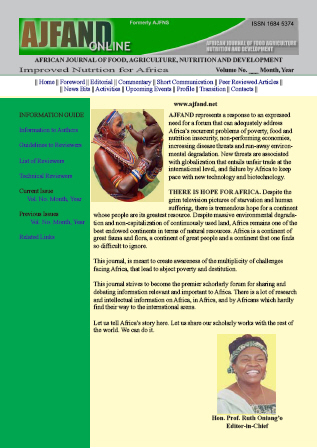
|
African Journal of Food, Agriculture, Nutrition and Development
Rural Outreach Program
ISSN: 1684-5358
EISSN: 1684-5358
Vol. 18, No. 3, 2018, pp. 13842-13860
|
 Bioline Code: nd18068
Bioline Code: nd18068
Full paper language: English
Document type: Research Article
Document available free of charge
|
|
|
African Journal of Food, Agriculture, Nutrition and Development, Vol. 18, No. 3, 2018, pp. 13842-13860
| en |
FACTORS ASSOCIATED WITH STUNTING IN DODOMA REGION, TANZANIA
Makori, N; Kassim, N; Kinabo, J & Matemu, A
Abstract
Child undernutrition is a major public health concern, claiming the lives of numerous
children below five years of age in the developing world. The objective of this study was
to assess the factors associated with stunting of children of age 6 – 23 months in Dodoma
Municipality and Chamwino District in Dodoma region. Dodoma region located in the
central zone of Tanzania was chosen for this study because of its high prevalence (56%)
of stunting among children under five years of age. A systematic random sampling
technique was used to choose wards, villages, and households that had children aged 6 -
23 months, resulting in 394 households participating in this cross-sectional study. A
standardized questionnaire was used to collect socio-demographic information and infant
feeding practices. Anthropometric measurements were taken as per WHO standard
procedures. A repeated 24-hour dietary recall was used to assess food intake among the
study population. Multivariate logistic regression using backward stepwise selection
method was used to obtain independent factors of stunting. The overall prevalence of
stunting was 40.4% (95% CI; 29.8; 50.9), Chamwino District had a higher prevalence of
stunting (44.3%) compared to Dodoma municipality (26.3%). Multivariate logistic
regression analysis showed that, age of introduction of complementary food [AOR =
13.3; (95% CI: 2.6 – 67.6)], maternal education [AOR = 5.5; (95% CI: 1.0 – 9.8)],
residence in Chamwino District [AOR = 3.2; (95% CI: 1.3 – 5.9)] were factors associated
with stunting. About half of the study population (49%) was introduced to
complementary foods early, the median age was four months instead of 6 months as
recommended by WHO. Infant’s diet was mainly cereal-based, other foods such as
animal food source, fruits, and dairy products were consumed by 18%, 11% and 7.1% of
children respectively. The dietary pattern of infants was not diversified as 47.7% of
infants scored 1 to 3 points out of 12 points categorized as low dietary diversity. Failure
to attain normal growth pattern is the most prevalent form of undernutrition in childhood.
Associated factors are many, diverse and interrelated. The present study identified
maternal education, early introduction of complementary foods and being a resident of
Chamwino District as factors to be associated with stunting. Prioritization of identified
factors serves as a highlight for better planning of nutrition intervention programs that
intend to promote child growth.
Keywords
Stunting; nutrition status; 6 – 23 months; dietary diversity and complementary food
|
| |
© Copyright 2018 - African Journal of Food, Agriculture, Nutrition and Development
Alternative site location: http://www.ajfand.net/
|
|
